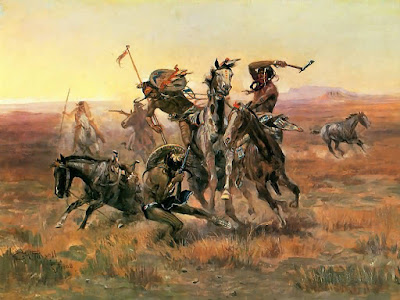 |
| Russell Fredrick Tharp |
After Russell Tharp arrived in Spokane, he took up a more
Euro-American lifestyle. At the age of twenty-three, Russell married Mary E.
Dawkins, a Christian Scientist. In the next years, he would be employed on
various jobs including: Financial Officer for American Zinc, Lead and Smelting
Co. in Ione, Washington; Accountant for a car dealership; Financial Officer for
Eastern State Hospital (from which he retired), and Realtor for Lakeshore Real
Estate, Priest Lake, Idaho.
Separated from his Blackfoot cultural roots in Montana,
Russell blended smoothly into the Spokane community and lived there for the
rest of his life. It was not until Russell retired from Eastern State Hospital
that his grandson Clancy Clark got to know him, and Clancy described him as
follows: “Russell was soft spoken, but direct in his words. He held a clearly
defined position in the family which granted him great respect.” Russell was
trustworthy, dependable and showed respect for all types of people.
In reflecting on his interactions with Russell, Clancy
recalls one moment that is exemplary of his personality in this way:
During the summer of 1987, I had become
enthralled in fishing. Running up and down the beach of Priest Lake, I would
display my recent catches. Apparently, Russell noticed my love for fishing and
stopped me one day in his home. He handed over a small metal box and said, “I
think you could use this.” Slightly taken back because he rarely spoke directly
to me, I took the box and ran into one of the empty rooms in the house. Inside
the box, I found an assortment of tied fishing lures that he had used when he
was young. So excited, I softly closed the box and safely guarded it from harm.
To this day, I have not used the lures for I see them as symbols of his sincere
kindness. Somehow, I feel if I were to lose a lure, I would be going against
his good will.
This brief moment with Russell would be
one of the last times I would interact with him. In January of 1990, Russell
died of pancreatic cancer. At his wishes, he spent the last weeks of his life
in his home with my mother and other nucleus family members. As my mother
related later, the last few days were extremely powerful and heart felt. It was
an emotionally and physically draining experience which allowed for long needed
dialogue.
Clancy Clark’s further reflections
on his grandfather and his heritage are:
Russell’s death became a familial
rebirth. We had always cherished our heritage. My parents stressed the
importance of respecting all of our roots from the Pennsylvanian Dutch to the
Blackfoot; all equally important to the make-up of my character. For the first
time, I looked beyond the simple blood connection to my Blackfoot heritage. Why
did Russell speak so little about the reservation? Why did my mother know so
little? Who could I talk to who would know more?
Over the last seven years, my questions
have been answered. Most of the confusion about our family background is
attributed to the atmosphere of Montana in Russell’s childhood. He wanted to
leave it all behind for a better life. However, Russell never completely
severed his ties to the Blackfoot Reservation. We learned that he had valued
his heritage more than we realized.
Although Russell never took an active
role in conveying his past, I as well as my family have attempted to restore
our lost past and revitalize our Native American heritage though academia,
letters, family records, and general dialogue.
As time goes on, I hope to gather more
information to both better understand his life and the lives of other Native
Americans coming out of this period of forced assimilation. The cultural
salvage work that I am conducting has shown the pain felt by many of my
ancestors. The void in my heritage stems from federal policy and educational
programs of the late 1800s and early 1900s. Fortunately, Russell Tharp
preserved our Blackfoot heritage for coming generations.
Written by Dr. Clancy J. Clark







